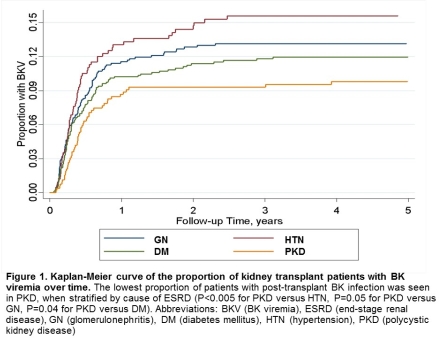Kidney Transplant Patients with Polycystic Kidney Disease Have a Lower Risk of Post-Transplant BK Infection Compared to Other Causes of ESRD
S. Panzer, C. Plafkin, B. Astor, A. Djamali, T. Singh.
University of Wisconsin Madison, Madison, WI.
Meeting: 2018 American Transplant Congress
Abstract number: 134
Keywords: Infection, Kidney transplantation, Polyma virus
Session Information
Session Name: Concurrent Session: Kidney Transplant Goes Viral
Session Type: Concurrent Session
Date: Sunday, June 3, 2018
Session Time: 4:30pm-6:00pm
 Presentation Time: 5:06pm-5:18pm
Presentation Time: 5:06pm-5:18pm
Location: Room 606/607
Purpose: Polyomavirus-associated nephropathy is associated with high rates of allograft loss among kidney transplant patients. Whether the cause of native end-stage renal disease (ESRD) impacts the risk of BK infection is unclear.
Methods: Adult kidney transplant recipients from January 1993 through December 2014 with ESRD due to polycystic kidney disease (PKD, N=549), diabetes mellitus (DM, N=947), hypertension (HTN, N=442), or glomerulonephritis (GN, N=803) were included. The primary outcome was incidence rate of post-transplant BK infection (defined by first diagnosis of BK viremia post-transplant).
Results: Of the 2,741 patients in the study, 327 patients developed post-transplant BK infection over a median follow-up time of 4.5 years. The incidence rate of BK infection was lowest in patients with PKD (1.46 per 100 person-years) compared to other causes of ESRD (DM=2.06, HTN=2.65, and GN=2.01 per 100 person-years).  A diagnosis of PKD was associated with a lower risk of post-transplant BK infection (age-adjusted hazard ratio=0.68, 95% CI 0.49-0.96, P=0.03), compared to other etiologies of ESRD. The lower risk of BK infection in PKD patients was maintained in a model adjusted for age, sex, race, dialysis pre-transplant, duration of dialysis, donor status, donor age, delayed graft function, HLA mismatch, induction immunosuppression use, and serostatus of donor and recipient (adjusted hazard ratio [aHR]=0.67, 95% CI 0.48-0.95, P=0.02). There was no significant difference in the risk of BK infection among GN patients when stratified by GN subtype (IgA nephropathy, focal segmental glomerulosclerosis, membranous nephropathy, lupus nephritis, or ANCA-associated vasculitis).
A diagnosis of PKD was associated with a lower risk of post-transplant BK infection (age-adjusted hazard ratio=0.68, 95% CI 0.49-0.96, P=0.03), compared to other etiologies of ESRD. The lower risk of BK infection in PKD patients was maintained in a model adjusted for age, sex, race, dialysis pre-transplant, duration of dialysis, donor status, donor age, delayed graft function, HLA mismatch, induction immunosuppression use, and serostatus of donor and recipient (adjusted hazard ratio [aHR]=0.67, 95% CI 0.48-0.95, P=0.02). There was no significant difference in the risk of BK infection among GN patients when stratified by GN subtype (IgA nephropathy, focal segmental glomerulosclerosis, membranous nephropathy, lupus nephritis, or ANCA-associated vasculitis).
Conclusions: ESRD due to PKD is associated with a decreased risk of post-transplant BK infection. BK infection primarily establishes itself in proximal renal tubular epithelial cells. The renal tubular epithelial cells in PKD are unique; they are in a proliferative but nondifferentiated state. Whether this characteristic of renal tubular epithelial cells alters the BK viral reservoir or replication in PKD patients warrants further study.
CITATION INFORMATION: Panzer S., Plafkin C., Astor B., Djamali A., Singh T. Kidney Transplant Patients with Polycystic Kidney Disease Have a Lower Risk of Post-Transplant BK Infection Compared to Other Causes of ESRD Am J Transplant. 2017;17 (suppl 3).
To cite this abstract in AMA style:
Panzer S, Plafkin C, Astor B, Djamali A, Singh T. Kidney Transplant Patients with Polycystic Kidney Disease Have a Lower Risk of Post-Transplant BK Infection Compared to Other Causes of ESRD [abstract]. https://atcmeetingabstracts.com/abstract/kidney-transplant-patients-with-polycystic-kidney-disease-have-a-lower-risk-of-post-transplant-bk-infection-compared-to-other-causes-of-esrd/. Accessed December 19, 2025.« Back to 2018 American Transplant Congress
